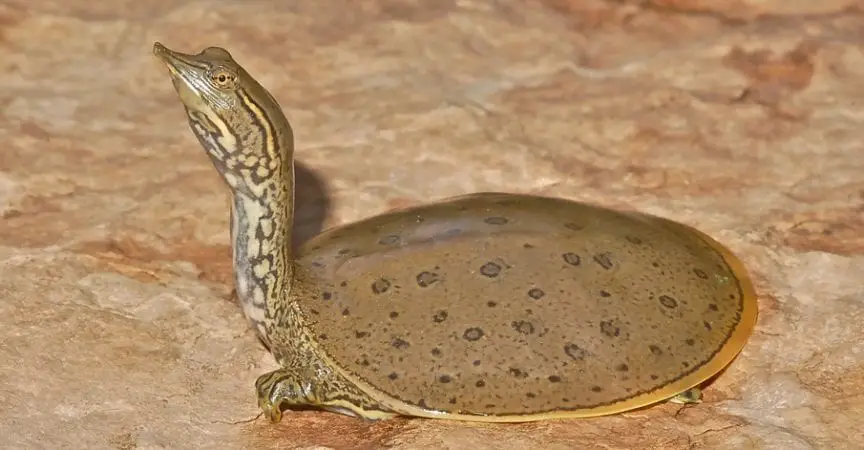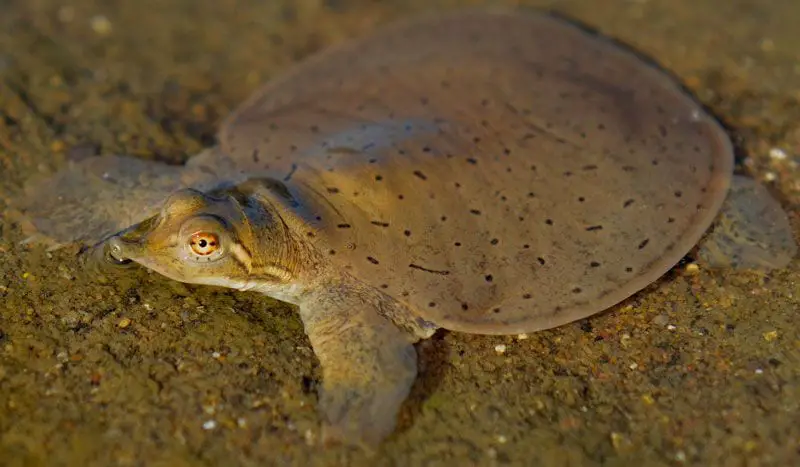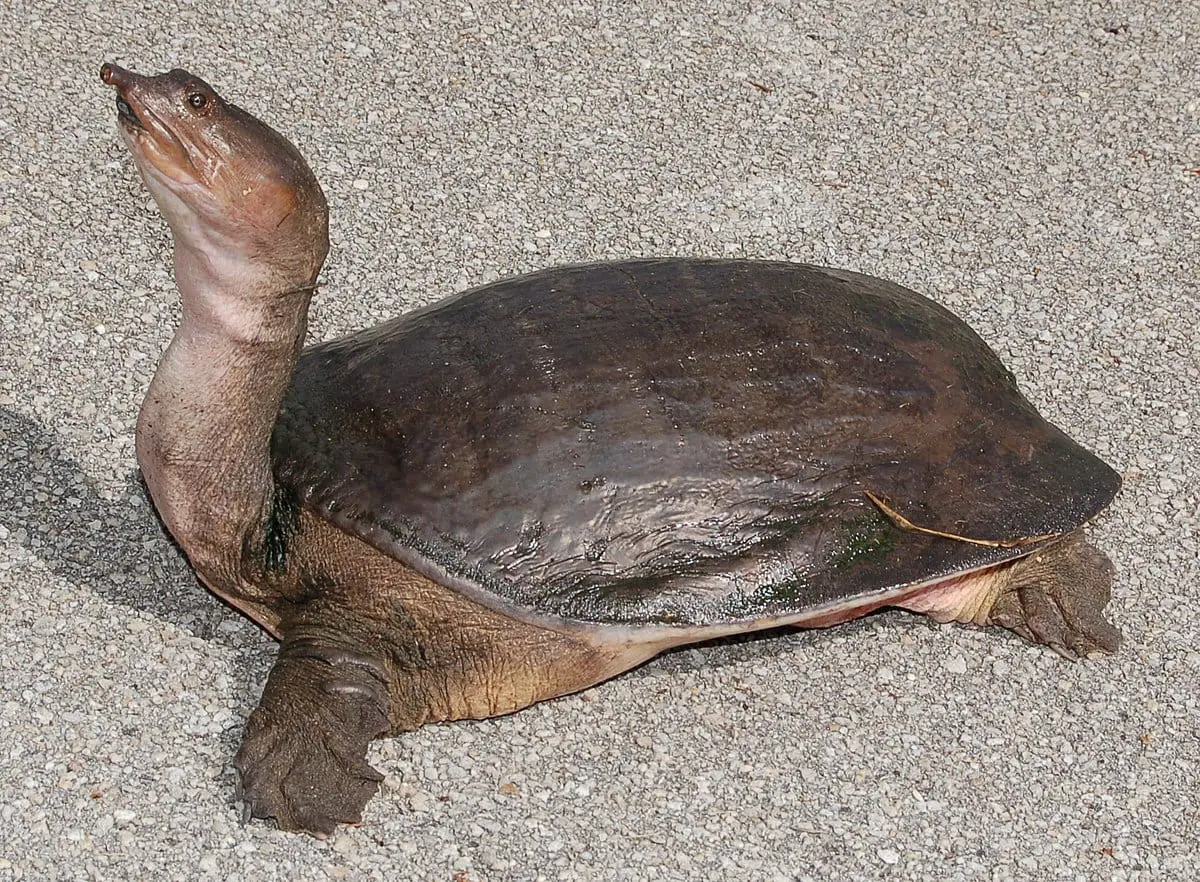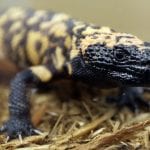Scientific Facts
| Common Name: | Smooth Softshell Turtle |
| Scientific Name: | Apalone Mutica |
| Life Span: | More than 20 Years |
| Length: | Average: 12 inches |
| Clutch Size: | 15 to 25 eggs |
| Habitat: | Major river systems |
| Country of Origin: | North America |
Physical Description

In general, softshell turtles are among the most recognized species of turtles in the world. One reason is their uniqueness in terms of appearance. They have a pancake-like feature, with no bony scutes on their shells, and snorkel-like neck and head. They also have an adaptation similar to fishes, as they can breathe underwater. Their personality and intelligence also make them interesting as pets.
Smooth softshell turtles are medium to large in size. The female turtles have a back shell, which is 16.5 to 35.6 cm in length. Needless to say, females are bigger than males, as males have shells that are 11.5 to 26.6 cm in length. Just like other varieties of the softshell turtle’s species, Apalone Mutica turtles have a carapace that is covered by skin rather than the hard scutes that are common with other turtles.
The carapace is ovoid in form and lacks spines on the front edge. The color pattern of the carapace varies from olive to orange hues. Female turtles usually have a brown or tan carapace, and males have a gray or brown carapace. Both male and female turtles have dark marks, streaks, spots, or blotches on their carapace, though females have a blotchier pattern.
They also have a white or gray plastron, with no markings. These turtles have visible underlying bones. The dorsal coloration of a turtle’s head, tail, and limbs look similar to their carapace. An orange or cream-colored line bordered in black extends from the back of every eye to their neck. Juvenile turtles look similar to the adults. Hatchlings, on the other hand, have olive or brown carapace with several marks on their carapace.
Smooth Softshell turtles have round nostrils with tubular snouts. Their nostrils are positioned inferior. They also do not have a septal ridge. Male turtles have thicker tails compared with females, which is common among all species of turtles. The anal vent of male turtles are located near the tip of the tail, while females have theirs located near the edge, or under the carapace. Females also tend to have longer hind claws than males, while males have longer foreclaws than females.
These turtles are labeled as the most aquatic among all softshells in North America. Their aquatic nature is a result of the variety of morphological and behavioral adaptations. The skin that covers their shell requires a high rate of water exchange, usually at 6.3 ml/100 g wet BM/hour. The lining of their pharynx and cloaca allows the uptake of oxygen from the water.
On top of that, the surface of their skin and shell is cutaneous, which means that they have the capacity to increase the permeability of water and gases. For example, these turtles lose around 64% of carbon dioxide produced during respiration through their skin. Their snout and long neck also contribute to their capacity to stay submerged in water for long periods of time.
It is quite easy to confuse Smooth Softshell turtles with spiny softshell turtles. However, these two species can be distinguished by carefully looking at their carapace. Spiny softshell turtles have spines on the front edge of their carapace, thus the name, with their shells usually having a sandpaper texture. On the other hand, Smooth Softshell turtles do not have these characteristics.
Geographic Range
Smooth softshell turtles are native to the areas of North America and spread throughout the central and south-central part of the United States. Their range further extends from New Mexico, Pennsylvania, to the south of the Florida panhandle.
These turtles are thought to be extirpated from Pennsylvania and are believed to occur in North America since the Cretaceous Period. These claims have not yet been supported by fossil evidence. These turtles have also been introduced to Europe, particularly in France.
Two specific subspecies of Smooth softshell turtles have been recognized. One is the midland smooth softshell turtles, which are found in the Central United States, while the Gulf coast smooth softshell turtles are also found in Louisiana to the Florida panhandle.
Habitat
Smooth softshell turtles are found typically along with major river systems, including Missouri, Ohio, and Mississippi rivers. They love large streams and rivers with medium to fast currents. In river systems, these turtles had the highest populations, especially in the main channels and open side channels of the Ohio and Mississippi Rivers.
Despite loving riverine locations, they are also found in bogs, lakes, ponds as well as other drainage ditches. They prefer areas with mucky and sandy bottoms, with little aquatic vegetation. In general, they try to avoid rocky systems with rocky substrates.
They also have microhabitat preferences. Male turtles were frequently observed than adult and sub-adult females in shallow depths along the river. Hatchlings love shallow areas along the river. Possibly, this is their natural way of avoiding larger aquatic predators.
Lifespan
Unlike other turtle species, smooth softshell turtles do not usually develop growth annuli on their shells, making them quite difficult to age in the field. The lifespan of these turtles is unknown in the wild. Specimens in captivity are recorded to have lived more than 11 years, and they are also believed to survive up to 20 years or more.
Development
The embryonic development among smooth softshell turtles is being classified into three categories – division of cells and development of tissues, organogenesis, and embryo growth right before the hatching stage. The timing and scheduling of these stages are associated with the three periods that correspond to their incubation.
Sex identification among smooth softshell turtles is not based on temperature, and equal proportions of hatchings are male and female. Through time, the round shape of hatchlings changes into an oval shape. However, there is no change in the shape of the plastron as the hatchlings continue to grow, with minimum change in the length ratio of the straight carapace to the plastron.
Once the plastron of these turtles has reached a 60 mm minimum length, individual turtles can be sexed through physical characteristics. Unlike several other turtle species, smooth softshell turtles do not form growth annuli on their shells. For this reason, it becomes difficult for them to age in the field.
The growth of these turtles usually happens from May to September, while the growth rates are at its highest from June to August. Male turtles grow at an average of 1.95 mm every month. Most species of turtles go through indeterminate growth, even though this has not yet been verified through records for smooth softshell turtles.

Feeding and Diet
In the wild, smooth softshell turtles are carnivores. They mainly feed on macroinvertebrates, including aquatic crustaceans, crayfish, and aquatic insects. They also eat amphibians, fish, worms, and mollusks. They love hiding along lake floors where they can conveniently ambush some passing prey.
Their eating habit is similar to that of other softshell turtle species. If you have them as pets at home, you can also feed them a diet of fish, mealworms, insects, prawns, crayfish, mussels, crickets, earthworms, as well as commercial pellets.
Smooth softshell turtles are known to hunt on both water and inland. They can be described as ambush predators. They usually conceal themselves in the substrate, then using their long neck to grab passing prey. They are also observed to show pharyngeal gulping, wherein they suck in small prey organisms.
They are also found to use their nose in seeking food in vegetation and sediment. Female turtles use deeper water in order to look for food, while the male turtles forage around shallow water, especially those that are near the shore. Even though the areas of foraging may differ between sexes, the size of food does not vary with sex or size.
Behavior
Because of the high frequency of time that these turtles spend in the water, most movements recorded among smooth softshell turtles are aquatic-based. When the breeding season comes, females usually move around land bars while searching for a suitable habitat for nesting.
These turtles are known to use touch and body language to communicate. Male turtles use their touch to sense females that they might mate with. There are no studies that show how these turtles actually communicate. However, their relative species, the spiny softshell turtles, use touch, sight, vibrations as well as chemical signals in order to understand their environment.
Smooth softshell turtles are considered as the most aquatic among all softshells in North America. Morphological and behavioral adaptations allow their aquatic nature. These turtles can stay submerged for long periods of time, made possible by their long neck and snout.
They usually buried in the substrate of a body of water that is deep enough so that their snout reaches the surface barely. In order to achieve this position, a turtle pushes itself into the sediment, head-first, pulling itself using its front limbs while also pushing along with its hind limbs. When their body is already positioned tilting downward, they stir the sediment. The material then covers the turtle so that only the head becomes visible.
These turtles also hibernate. They do so by burying themselves in the substrate underwater. Around March or early April, these turtles emerge from winter hibernation. The activities of these turtles are usually observed from May to September.
In southern areas, including New Mexico, smooth softshell turtles are generally active from April to October. After they wake up from hibernation, these turtles are observed to bask on sand bars, as well as in muddy bars within just a few meters of the edge of the water. Aside from these locations, rocks and logs near the water can also be used. These turtles usually extend their neck, tucking their limbs into their shell when basking.
These turtles are very alert and wary, usually abandoning their basking sites when perceiving danger. They are agile specimens, both on land and in water, allowing for a fast escape from predators. When calm, they are generally solitary.
Health
Due to the soft nature of the turtles’ carapace, they are especially prone to injuries, which may easily result in infections. As such, it is very important to keep a close eye on the carapace of your pet turtles. Ear infections and intestinal parasites are among the most common health problems that keepers are most likely to encounter.
In order to ensure the health of your turtles, an annual visit to the veterinarian will help in making sure that infestations of internal parasites are detected early. This can help in the prevention of early death among your pets.
Just like other aquatic turtle species, making sure that the water of your smooth softshell turtle is clean inside their enclosure is important to their health. Make sure that their water tank comes with a good filter and pump set up.
At the same time, the water also has to be replaced regularly. Basking helps a lot in drying the shell of the turtle, thus preventing infections. As such, make sure that the basking area is huge enough for the turtle to leave the water completely and be able to dry off. Calcium and vitamin deficiency is also a very common health concern. Make sure to supplement your turtle’s diet from time to time.
Predators
Adult smooth softshell turtles have few predators in the wild. Eggs and juveniles are preyed on naturally by herons, ray-finned fish, striped skunks, red foxes, and raccoons. They are also in danger due to humans that are known to hunt adult smooth softshell turtles for food.
Because of these turtles’ high agility both on land and in water, as well as their strategies to avoid, adult turtles have few natural predators. Among their main predators are alligators and humans. Predators of hatchlings include other turtles, fish, shoreline birds, water snakes, bald eagles, as well as other mammals. Nest predation usually comes from skunks, raccoons, fire ants, crows, fire larvae, red foxes, dogs, moles, as well as other small mammals.
Conservation and Threats
Smooth softshell turtles are not listed as endangered. They also do not have a special status based on their population. They are not considered as vulnerable or threatened by organizations as IUCN, CITES, or the US Endangered Species Act. Even though this species is safe, little data is available in making a confident assessment. As of the moment, this species is locally common and widespread, thanks to the availability of suitable habitat.
However, the primary threat to populations in the wild is the contamination of rotenone. This substance is used to kill unwanted fish. When it starts to contaminate the waters where smooth softshell turtles live. These chemical substances will inhibit the underwater breathing of turtles.
Their ability to absorb oxygen out of the water has also made this species susceptible to water pollution. Other negative impacts on these turtles also include habitat degradation, changes in hydrological regimes, harvesting for food, as well as an increase in human disturbances in their nesting sites.
Disturbances from humans also include boating nearby nesting sites, with the waves from the boat causing egg exposure and erosion. These turtles are also caught as by-catch in the commercial fishing industry. Zealous efforts in conserving smooth softshell turtles need to include the protection of the waterways, as well as the surrounding land area, which is known to provide support to a large population of these turtles.
Reproduction
Activity for breeding among smooth softshell turtles usually happens from April to June, and even into September. Male turtles usually look for females by approaching other adult turtles. If the individual turtle approached turns out to be male, the response is usually passive, though it can also become aggressive in certain occasions.
Females who are non-receptive are usually aggressive. In fact, during the breeding season, many male turtles have been observed with wounds that are inflicted by the female turtles. Females that are receptive, however, are passive to male turtle advances. It has been observed that many males are present nearby a receptive female, all attempting to mate with her. When there is only one male turtle present, the female may end up chasing the male.
Copulation usually happens in the water, with the receptive female turtle mounted from behind. For males to successfully mount females, deep water is usually required. A male turtle needs to swim in place for about 20 minutes just to keep his position. Within this period, the male also needs to keep its vents properly aligned.
Breeding
Female Smooth softshell turtles lay only a single clutch every year. The average clutch size ranges from 15 to 25 eggs. According to records, the minimum observed the size of the clutch is 1 egg, while the maximum is 33 eggs. Clutches that are laid later in the season are generally smaller compared to the ones that are laid earlier in the season.
The size of a clutch depends on the straight carapace length of the female. Eggs feature a spheroidal shape, looking like ping-pong balls. In a usual clutch, 75% of the eggs are high to survive. Flooding and predation may have an impact on the survival of the eggs.
In general, eggs hatch in about 8 to 12 weeks. The frequency in hatching is observed at the highest around August and September. The hatchlings usually use their front claws in breaking right through the egg, depending on their claws than their caruncle. Their egg tooth is less used in contrast with other species.
The hatchlings emerge generally from the nest around sunset. When they finally hatch, the hatchlings are entirely independent. Recently hatched turtles average 4 cm. Their caruncles usually drop off in about a week, while the umbilical scar is typically 2 mm in diameter.
Male turtles typically become sexually mature when they reach their fourth year, and when their mean plastron length reaches 80 to 85 mm. The females, on the other hand, become sexually mature in their ninth year with a mean plastron length ranging from 140 to 150 mm.
Mature turtles attempt to mate right away the moment they emerge from hibernation. The volume of mature testes may vary depending on the season, with their testes reaching a maximum diameter size right before hibernation starts. Around April and May, the vas deferens of male turtles become swollen, with a size of 2 mm in diameter. By June, their vas deferens is no longer swollen, but become filled with sperm again by October.
FAQ Section
Where do smooth softshell turtles live?
These turtles are found in river drainages in Texas, Kansas, Nebraska, and Oklahoma. They are considered primarily riverine species, which means that they are closely associated with large rivers, sandbars, and sandy bottoms.
Are smooth softshell turtles endangered?
Even though the population of smooth softshell turtles is considered stable in the United States, a specific variety, the spiny softshell turtle has been listed recently as endangered species in Canada. The reason for this is the observation that many of these turtles do not even reach their reproductive stage.
What do smooth softshell turtles eat?
In the wild, Softshell turtles eat a wide variety of amphibians, insects, eggs, as well as fish. On the other hand, in captivity, they are primarily carnivores. Still, they can easily adapt to turtle pellets given to them. Gut-loaded crickets, worms, fish, and other prey items can also be offered to these pets.
Are smooth softshell turtles dangerous?
Even though these turtles are prized because of their taste, these turtles are known to be dangerous critters. They have powerful jaws, unusually long necks, and clawed feet, which can cause damage when they are handled carelessly.
Do smooth softshell turtles bite?
This species of turtles is a wary variety. This means that you can find them immediately jumping into the water when they feel disturbed or threatened. They are amazingly fast swimmers. When they are handled and picked up, their first reaction is scratching and biting vigorously.
How big do smooth softshell turtles get?
These turtles can get big. Even though their average size is only around 12 inches, they can grow up to about 2 feet. They can live for a long time as well.
Can smooth softshell turtles live out of water?
These turtles are highly aquatic, rarely leaving the water. In fact, they prefer living in muddy-bottomed, or sandy waters, where they spend long periods buried in the substrate. Their snorkel-like noses and long necks allow them to easily have access to the surface to breathe.
What is the importance of smooth softshell turtles?
These turtles are important predators in various aquatic environments. They eat aquatic insects and other crustaceans.
Do smooth softshell turtles need UVB light?
UVB lights cannot be compromised when preparing an enclosure for smooth softshell turtles. They need to get 12 hours of natural sunlight, or, as an alternative, UVB radiation every day. Vitamin D3, along with calcium, is very important for bone growth.
Can smooth softshell turtles eat lettuce?
Among the recommended greens that can be fed to smooth softshell turtles include dark green leafy lettuces, including romaine. However, mustard greens, collard greens, kale, dandelion greens are not that nutritious enough for these turtles. When providing leafy greens, make sure that they are given the appropriate calcium to phosphorus levels.
Does the bite of smooth softshell turtles hurt?
Just like common snapping turtles, these smooth softshell turtles have long necks, allowing them to reach almost all the way their bodies. Even smaller turtles can give a painful bite, while bites from adult turtles can become really serious.
How fast is a smooth softshell turtle?
Even though most specimens of smooth softshell turtles are even-tempered, they can move really fast when agitated. They are fast both in water and on land, with land speeds recorded at 15 miles per hour.
Do smooth softshell turtles hibernate?
Yes, they do. It is common for turtles, in general, to hibernate during the cold season.
Do smooth softshell turtles need a basking area?
Yes, essentially. It is imperative for smooth softshell turtles to have a basking area inside an enclosure. While they mainly love water, they still surface to bask under natural sunlight.
How do you tell the sex of smooth softshell turtles?
One of the easiest ways to determine the sex of a turtle is to look at the tail length. Female turtles have skinny and short tails while males have thick, long tails, with their vent positioned closer to the end of the tail.
What are the predators of smooth softshell turtles?
These turtles are often eaten by raccoons, foxes, and skunks. Young turtles are also a target for herons and large fishes. Adults and killed for food by humans.
Can smooth softshell turtles eat bread?
Turtles in captivity will most likely eat whatever you feed them. However, even as a treat, bread is not a recommended food for turtles.



